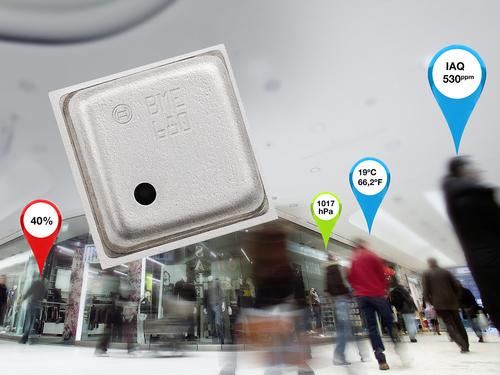This Sensor Turns Your Smartphone Case Into a Weather Station
A tiny new environmental sensor package from Bosch Sensortec is carving out an unusual niche in the world of smartphones and, at the same time, serving as a novel business model for sensor manufacturers.
March 11, 2016
A tiny new environmental sensor package is carving out an unusual niche in the world of smartphones and, at the same time, serving as a novel business model for sensor manufacturers.
The BME680 environmental sensor, developed by Bosch Sensortec, is now being incorporated, not in a mobile phone itself, but in the plastic case that fits around it. The case, called the Smartcase and built by i-Blades, Inc., will enable smartphones to display air quality measurements, along with temperature, altitude and humidity -- without ever requiring a hardware change to the smartphone’s electronics.

Bosch Sensortec’s BME680 consists of an eight-pin package measuring 3 x 3 mm and incorporating gas, pressure, temperature and humidity sensors for environmental monitoring. (Source: Bosch Sensortec)
“With the Smartcase, you have a personalized weather station and air quality monitor with you at all times,” Jeanne Forget, vice president of marketing for Bosch Sensortec, told Design News. “It’s a way for the consumer to retrofit those features into their smartphones.”
It’s also a way for Bosch to deliver its sensor technology to the smartphone market. With the BME680 the company decided it could move its technology into the smartphone market more quickly by working with the Smartcase manufacturer, instead of the manufacturer of the next-generation phone. “With a (business) model like this, we can accelerate the penetration of this technology into the market,” Forget said. “It would take longer if we had to go through the design-win and design-in cycles.”
Bosch Sensortec started the odyssey a few years ago with the creation of the pressure, temperature, and humidity sensors. More recently, it added the gas sensor, capable of measuring airborne organic compounds and assessing air quality. Bosch executives saw the package as having potential in the growing market for mobile and wearable health products.
READ ABOUT ALTERNATIVE ENERGY:
”We believe it will become a universal sensor because measurement of air quality, indoor and outdoor, has a growing impact on health,” Forget said.
The BME680 consists of an eight-pin, land-grid array (LGA) package measuring 3 x 3 x 0.95 mm and incorporating the gas, pressure, temperature, and humidity sensors. Its sensors detect a broad range of gases from paints, lacquers, paint strippers, cleaning supplies, glues, adhesives, and alcohol.
Bosch worked with i-Blades to integrate the technology into the Smartcase – an injection-molded plastic case that fits around the phone and contains an embedded microcontroller and software. The resulting product communicates with the phone through an on-board port, enabling users to easily see the air quality readings on their cell phone displays. “You have an app on the phone that gives you a traffic light signal that can say, ‘Hey, the air is bad, think about opening a window,’ Forget said.
Bosch foresees the sensor package being used in a wide variety of applications, including personal weather stations, fitness monitors, and home automation systems, among others. “We see it as having a lot of value,” Forget said. “We are now sampling customers in the smartphone, wearables and IoT markets.”
Senior technical editor Chuck Murray has been writing about technology for 32 years. He joined Design News in 1987, and has covered electronics, automation, fluid power, and autos.
Like reading Design News? Then have our content delivered to your inbox every day by registering with DesignNews.com and signing up for Design News Daily plus our other e-newsletters. Register here!
About the Author(s)
You May Also Like

.jpg?width=300&auto=webp&quality=80&disable=upscale)

